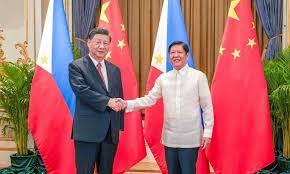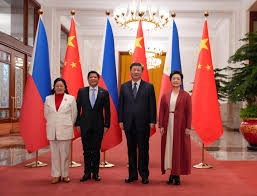The geopolitical chessboard in the South China Sea has entered a new phase of escalation following the bold legislative maneuvers by the Philippine government. Last Friday, Manila formally enacted two long-anticipated laws designed to decisively reinforce its jurisdiction and governance within its Western Exclusive Economic Zone (EEZ)—an area where China has persistently engaged in aggressive infringement for over a decade. The passage of these laws in October has triggered an immediate and furious backlash from Beijing, underscoring the high stakes of the territorial dispute.
The implementation of these legislative acts has been met with extraordinary diplomatic friction. China’s Foreign Ministry promptly summoned the Philippine Ambassador, demanding an explanation and a formal protest regarding the new maritime regulations. Beijing views these laws as a direct provocation, claiming they violate China’s “Nine-Dash Line” claims which encompass the majority of the contested waters.

The Diplomatic Fallout and China’s Stark Warning
The diplomatic protest quickly transcended mere bureaucratic formality, escalating to the highest levels of Chinese leadership. The Foreign Ministry announced this week that it would soon relay a direct message from China’s supreme leader, Xi Jinping, regarding the Philippines’ new policy—a move reserved for matters of utmost national significance.
The language from Beijing has been notably hostile, with implied threats of severe retaliation. There is speculation that the Philippines could face “profound economic and military sanctions” for taking steps that, in Beijing’s view, further ignite tensions against the Marcos administration in the South China Sea. China’s state-controlled media, The Global Times, was particularly scathing, publicly warning that the Philippines and its people would “pay a price” for “slandering” China in the international community regarding its activities in the contested waters.
China’s claim to nearly the entirety of the South China Sea is historically sweeping, encompassing international waters and the EEZs of its neighbors—sometimes extending up to 1,000 nautical miles from the Chinese mainland. Beijing leverages a dubious interpretation of historical navigation to justify these vast claims, a stance that has been universally rejected by the international legal community.
Manila’s Unwavering Stance: Aligning with International Law
Despite the intense pressure and overt threats from its giant northern neighbor, the Philippines has maintained an assertive and legally grounded position.
President Ferdinand Marcos Jr. articulated the nation’s rationale with clarity and confidence, asserting that China has no basis to act as if it possesses rights over the Philippines’ recognized EEZ. The country, he stated, is simply complying with internationally recognized rules, specifically those established by the United Nations Convention on the Law of the Sea (UNCLOS).
In a direct message to both the domestic audience and the international community, President Marcos emphasized the legal foundation of the new laws:
“With these pieces of legislation, we align domestic laws with international law, specifically the United Nations Convention on the Law of the Sea or UNCLOS, improve our capacity for governance, and reinforce our maritime policies for economic development and for national security. Our people, especially our fisherfolk, should be able to pursue their livelihood free from coercion and harassment.”
This statement underscores a dual strategy: domestically strengthening the legal framework, and internationally asserting compliance with the global rule of law.
The Two Pillars of New Legislation

The Philippines’ recent legal action is embodied in two key revised and improved acts:
1. The Revised Maritime Zone Act: While the Philippines’ EEZ is already clearly defined under UNCLOS, the revision of this act formally anchors the country’s sovereignty by enshrining its boundaries into national law. Crucially, this legislation formalizes the preferred term for the contested waters within the Philippines’ EEZ. For the purpose of Philippine law, the portion of the South China Sea that falls within its EEZ is now exclusively referred to as the West Philippine Sea (WPS). This seemingly subtle linguistic shift is a powerful political statement, deliberately removing any reference to “China” from the area’s name and underscoring Manila’s claim of sovereign rights.
2. The New Archipelagic Sea Lanes Act: This act is designed to manage and secure the archipelago’s vital waters. It delineates a set of designated sea lanes for merchant shipping and international navigation. In a demonstration of responsible international conduct, Manila plans to submit these three new standard routes to the International Maritime Organization (IMO) for debate and eventual approval. This consultative process is rare; historically, only Indonesia has undertaken such a comprehensive process of consultation for its archipelagic sea lanes. By adhering to this rigorous international standard, the Philippines further validates its actions under the framework of UNCLOS and strengthens its legal standing against China’s arbitrary claims.
The Inescapable Shadow of the 2016 Ruling
The ongoing friction is inextricably linked to the landmark 2016 ruling by the Permanent Court of Arbitration in The Hague. That ruling definitively invalidated China’s expansive, historical claim over the South China Sea, determining that UNCLOS is based on physical distances—not historical events—and thus, China had no legal basis for its Nine-Dash Line.
However, despite this decisive international legal defeat, the China Coast Guard (CCG) continues its aggressive campaign to enforce China’s control within the Philippines’ EEZ. This harassment includes a range of hostile tactics:
Water Cannon Use: Targeting Philippine Coast Guard (PCG) and civilian vessels.
Ramming and Boarding: Physically obstructing and aggressively engaging Philippine vessels, including those belonging to the Bureau of Fisheries and Aquatic Resources (BFAR).
Confiscation: Seizing the vessels and equipment of Filipino fisherfolk, directly impacting their livelihood and national security.
The new Philippine laws are a direct response to this sustained campaign of coercion and a necessary measure to protect its citizens. By aligning its domestic laws with international mandates, the Philippines is sending a clear, unequivocal message: the time for ambiguity and submission is over.
Looking Ahead: The Geopolitical Tightrope
The legislative action by the Philippines is a calculated risk, a forceful step toward domestic sovereignty that immediately elevates the diplomatic crisis. China’s reaction—from summoning the Ambassador to threatening deep sanctions and involving its highest political authority—signals that Beijing views this as a major challenge to its regional hegemonic ambitions.
For the Marcos administration, this is a delicate geopolitical tightrope walk. The government is balancing the imperative to protect national security and the economic rights of its people, particularly the fisherfolk who depend on the West Philippine Sea for their survival, against the threat of potentially crippling economic and military retaliation from a global power.
The ultimate goal of the new laws is to establish a robust and legally impregnable domestic framework that provides the PCG and other government agencies with the necessary jurisdiction to defend the nation’s sovereign rights and assert control over its economic resources. As the Philippines awaits the specific response from President Xi Jinping, the entire region is closely watching. Manila’s move to unequivocally codify its sovereign rights under international law marks a decisive turning point in the long-running South China Sea saga, transforming it from a mere dispute over rocks and reefs into a fundamental contest over adherence to the global rule of law.





